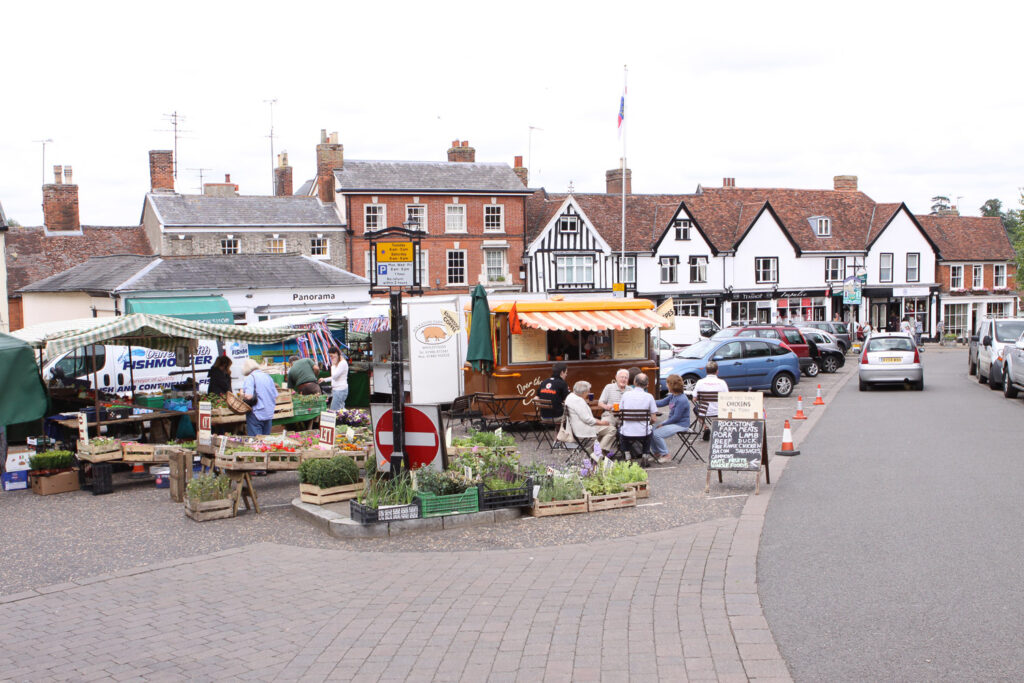Article by Simon Garrett
Framlingham’s market dates from at least 1270, the date of the earliest reference, but may have existed earlier. Many markets were permitted be a Royal Charter; none can be found for Framligham, and it was probably established by “prescriptive right”1, as being established since the reign of Richard I. This would imply Framlingham’s Market existed before 1200, but the first known reference is from 12702.

By 1270 Roger Bigod (5th Earl of Norfolk) had established three market days: Tuesday, Friday and Saturday. In addition there was a Michaelmas fair. By 1324-5 another fair had been added to be held on three days of Whitsun week. The number of markets and fairs suggests that by then Framlingham was a significant market town and business community.
Robert Hawes manuscript “History of Framlingham” in 1712 describes3 the market:
“The marketplace is almost a triangle about which the tradesmen have convenient shops for the Sale of Goods and Merchandise. And in the midst thereof is the butchery, with Severall shops under two great chambers, belonging to the lords of the manor where the stalls for the Fairs and Markets are laid up”
Also according to John Ridgard4:
Ten persons were listed as holding ‘Shoppes’ in Framlingham Market according to a late seventeenth-century Market Rental. A further thirty-five were listed as stallholders. Medieval documents, while listing burgesses and the total sums of money taken in rent from stallholders, did not specify, as does the seventeenth-century rental, the trades followed by the stallholders. Of these ten shopkeepers, who traded, presumably, from within the Markethouse, two were butchers and two were barbers: other shops were held by a glover, a shoemaker, a sadler, a pewterer and a chapman. There were twelve butcher’s stalls, six stalls held by chapmen, five by weavers and four by shoemakers. Other trades mentioned were a pedler, a mercer, a smith and finally a cobbler ‘For a lyttel shop’. Rents varied from 10s. for the larger shopkeepers down to 2s. paid by the weavers and 16d. paid by the shoemakers and the smith. Innkeepers and other tradesmen occupying permanent business premises round the market-place were not listed.
By 1712, from Robert Hawes account the market occupied its current location in Market Hill. At earlier times the location is not certain. In the days of Roger Bigod it is possible the market operated near the Castle.
The flourishing modern market operates on Tuesdays and Saturdays5.

Footnotes and sources
- Methodology, “Gazetteer of Markets and Fairs in England and Wales To 1516”, https://archives.history.ac.uk/gazetteer/summy.html ↩︎
- Framlingham market, “Gazetteer of Markets and Fairs in England and Wales To 1516”, see https://archives.history.ac.uk/gazetteer/suff.html#Fra ↩︎
- The History of Framlingham, in the County of Suffolk: Including Brief Notices of the Masters and Fellows of Pembroke-Hall in Cambridge, from the Foundation of the College, to the Present Time, Robert Hawes & Robert Loder, published 1798. ↩︎
- “Medieval Framlingham, Select Documents 1270-1524”, John Ridgard, Boydell Press for the Suffolk Records Society, 1985 ↩︎
- Framlingham Market, http://framlinghammarket.co.uk/ ↩︎
See also:
- “Potted History of Framlingham Market”, http://framlinghammarket.co.uk/framlingham-market-news/potted-history-of-framlingham-market/ . This source suggests Framlingham is a “Chartered Market”. This may not be true, as there is no evidence of a Royal Charter (see above).
- Framlingham facts, Suffolk Heritage Explorer, https://heritage.suffolk.gov.uk/media/pdfs/framlingham.pdf
